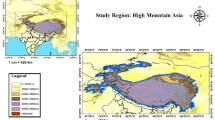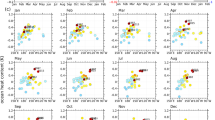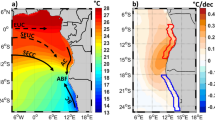Abstract
Lake surface water-heat exchange and its climatic attribution critically influence alpine lakes’ evaporation mechanism and water storage balance with climate change. Here, this paper first explored the hourly, daily, and monthly water-heat flux variations of the lake surface and their correlations with meteorological factors based on the eddy covariance turbulent flux observation over the Yamzhog Yumco, an alpine lake in south Tibet in the non-freezing period (April-December) in 2016 and 2017. We found that the average latent heat flux was much higher than the sensible heat flux on the lake surface from April to December. Meanwhile, the water-heat flux exhibited remarkable seasonal variation, with a prominent role of higher air temperature and humidity in summer jointly controlling the lake-air energy exchange. Moreover, the main controlling meteorological factors for the water-heat flux variation of the lake surface differed with diversified timescales. First, the lake-air temperature difference was the most significant meteorological factor related to sensible heat flux on the half-hourly, daily, and monthly timescales. Second, the latent heat flux was strongly positively correlated with wind speed and the synergies of wind speed and water vapor pressure deficit on the daily and half-hourly timescales. Third, the lake surface heat flux was significantly negatively correlated with net radiation flux on the daily and monthly scales. The negative correlation can be attributed to the seasonal variation of the water surface net radiation, and the phase difference in heat flux intensity caused by the lake-air temperature difference and heat capacity contrast. Our findings will hopefully improve the understanding of energy exchange and evaporation mechanisms for alpine lakes in a warming climate.
Similar content being viewed by others
References
Abadi M, Agarwal A, Barham P et al., 2016. TensorFlow: Large-scale machine learning on heterogeneous distributed systems. Proceedings of the 12th USENIX Symposium on Operating Systems Design and Implementation, USA, 265–283.
Biermann T, Babel W, Ma W Q et al., 2014. Turbulent flux observations and modelling over a shallow lake and a wet grassland in the Nam Co basin, Tibetan Plateau. Theoretical and Applied Climatology, 116(1/2): 301–316.
Chen D L, Xu B Q, Yao T D et al., 2015. Assessment of past, present and future environmental changes on the Tibetan Plateau. Chinese Science Bulletin, 60(32): 3025–3035. (in Chinese)
Chu D, Pu Q, Laba Z et al., 2012. Remote sensing analysis on lake area variation of Yamzho Yumco in Tibetan Plateau over the 40a. Journal of Lake Sciences, 24(3): 494–502.
Cui Y F, Liu Y B, Gan G J et al., 2020. Hysteresis behavior of surface water fluxes in a hydrologic transition of an ephemeral lake. Journal of Geophysical Research: Atmospheres, 125: e2019JD032364. doi: https://doi.org/10.1029/2019JD032364.
Cui Y F, Zhang X Q, Liu Y B, 2021. Radiative and aerodynamic contribution to evaporation: Eddy-covariance comparison between a plain and a plateau lake. Earth and Space Science, 8: e2021EA001913. doi: https://doi.org/10.1029/2021EA001913.
Dutra E, Stepanenko V M, Balsamo G et al., 2010. An offline study of the impact of lakes on the performance of the ECMWF surface scheme. Boreal Environment Research, 15(2): 100–112.
Fratini G, Ibrom A, Arriga N et al., 2012. Relative humidity effects on water vapor fluxes measured with closed-path eddy-covariance systems with short sampling lines. Agricultural and Forest Meteorology, 165: 53–63.
Garland M, Le Grand S, Nickolls J et al., 2008. Parallel computing experiences with CUDA. IEEE Micro Conference, USA, 28(4): 13–27.
Göckede M, Markkanen T, Hasager C B et al., 2006. Update of a footprint-based approach for the characterization of complex measurement sites. Boundary-Layer Meteorology, 118(3): 635–655.
Hack J J, Caron J M, Yeager S G et al., 2006. Simulation of the global hydrological cycle in the CCSM Community Atmosphere Model version 3 (CAM3): Mean features. Journal of Climate, 19(11): 2199–2221.
Han W, Zhang E L, Sun W W et al., 2023. Anthropogenic activities altering the ecosystem in Lake Yamzhog Yumco, southern Qinghai-Tibetan Plateau. Science of The Total Environment, 904: 166715. doi: https://doi.org/10.1016/j.scitotenv.2023.166715.
Howell J R, Mengüç M P, Siegel R, 2015. Thermal Radiation Heat Transfer. 6th ed. USA: CRC Press, 70–78.
** Z, Zhang X Q, 2020. Optimization method for alpine lake turbulent flux data based on micro-meteorological information utilization. Journal of Lake Sciences, 32(3): 877–886. (in Chinese)
Kljun N, Kastner-Klein P, Fedorovich E et al., 2004. Evaluation of Lagrangian footprint model using data from wind tunnel convective boundary layer. Agricultural and Forest Meteorology, 127(3/4): 189–201.
Kohavi R, 1995. A study of cross-validation and bootstrap for accuracy estimation and model selection. International Joint Conference on Artificial Intelligence, USA, 14(2): 1137–1145.
Laba Z, Ci Z, La B et al., 2012. Characteristics of climate change at Yamdrog Yumtso lake during the 1971–2009. Journal of Tibet University (Natural Science Edition), 27(1): 15–19.
Lee X, Finnigan J, Paw U, K T, 2004. Coordinate systems and flux bias error. In: Lee X, Massman W, Law B (eds). Handbook of Micrometeorology. Atmospheric and Oceanographic Sciences Library, Vol 29. Dordrecht: Springer. doi: https://doi.org/10.1007/1-4020-2265-4_3.
Lee X H, Liu S D, **ao W et al., 2014. The Taihu eddy flux network: An observational program on energy, water, and greenhouse gas fluxes of a large freshwater lake. Bulletin of the American Meteorological Society, 95(10): 1583–1594.
Lee X H, Massman W J, 2011. A perspective on thirty years of the Webb, Pearman and Leuning density corrections. Boundary-Layer Meteorology, 139(1): 37–59.
Li X Y, Ma Y J, Huang Y M et al., 2016. Evaporation and surface energy budget over the largest high-altitude saline lake on the Qinghai-Tibet Plateau. Journal of Geophysical Research: Atmospheres, 121(10): 470–485.
Li Z G, Lyu S H, Ao Y H et al., 2015. Long-term energy flux and radiation balance observations over Lake Ngoring, Tibetan Plateau. Atmospheric Research, 155: 13–25.
Liu H Z, Feng J W, Sun J H et al., 2015. Eddy covariance measurements of water vapor and CO2 fluxes above the Erhai lake. Science China Earth Sciences, 58(3): 317–328.
Liu Y B, Qiu G Y, Zhang H S et al., 2022. Shifting from homogeneous to heterogeneous surfaces in estimating terrestrial evapotranspiration: Review and perspectives. Science China Earth Sciences, 65(2): 197–214.
Ma R H, Yang G S, Duan H T et al., 2011. China’s lakes at present: Number, area and spatial distribution. Science China Earth Sciences, 54(2): 283–289.
Monin A S, Obukhov A M, 1954. Basic laws of turbulent mixing in the surface layer of the atmosphere. Contributions to Geophysics Institute of Academy Sciences, 24(151): 163–187.
McGloin R, McGowan H, McJannet D et al., 2014. Quantification of surface energy fluxes from a small water body using scintillometry and eddy covariance. Water Resources Research, 50(1): 494–513.
Nordbo A, Launiainen S, Mammarella I et al., 2011. Long-term energy flux measurements and energy balance over a small boreal lake using eddy covariance technique. Journal of Geophysical Research: Atmospheres, 116(2): D02119. doi: https://doi.org/10.1029/2010JD014542.
Ren X Q, Sun S F, Chen W et al., 2013. A review of researches on the lake numerical modeling. Advances in Earth Sciences, 28(3): 347–356. (in Chinese)
Sang Y F, Chen D, Gong T, 2020. What caused the decline of water level of Yamzho Yumco during 1975–2012 in the southern Tibetan Plateau? Journal of Geophysical Research: Atmospheres, 125, e2019JD031121. doi: https://doi.org/10.1029/2019JD031121.
Schindler D W, Bayley S E, Parker B R et al., 1996. The effects of climatic warming on the properties of boreal lakes and streams at the Experimental Lakes Area, northwestern Ontario. Limnology and Oceanography, 41(5): 1004–1017.
Segal M, Arritt R W, 1992. Nonclassical mesoscale circulations caused by surface sensible heat-flux gradients. Bulletin of the American Meteorological Society, 73(10): 1593–1604.
Shen P K, 2018. Observations and analyses of atmospheric turbulence in the Yamzhog Yumco Basin, south Tibet [D]. Bei**g: University of Chinese Academy of Sciences, 1–72 (in Chinese)
Shen P K, Zhang X Q, 2019. Observation of atmospheric turbulence characteristics over the Yamzhog Yumco, south Tibet. Journal of Lake Sciences, 31(1): 243–255. (in Chinese)
Tang H D, Cidan Y, Zeng C et al., 2021. Characteristics of the lake water level changes and influencing factors in Yamzhog Yumco in Tibet from 1974–2019. Journal of Arid Land Resources and Environment, 35(4): 83–89.
Tanny J, Cohen S, Assouline S et al., 2008. Evaporation from a small water reservoir: Direct measurements and estimates. Journal of Hydrology, 351(1/2): 218–229.
Van Dijk A, Moene A F, De Bruin H A, 2004. The principles of surface flux physics: Theory, practice and description of the ECPACK library. Netherlands: Meteorology and Air Quality Group, Wageningen University, 99: 525.
Wang B B, Ma Y M, Chen X L et al., 2015. Observation and simulation of lake-air heat and water transfer processes in a high-altitude shallow lake on the Tibetan Plateau. Journal of Geophysical Research: Atmospheres, 120(24): 12327–12344.
Wang B B, Ma Y M, Ma W Q et al., 2017. Physical controls on half-hourly, daily, and monthly turbulent flux and energy budget over a high-altitude small lake on the Tibetan Plateau. Journal of Geophysical Research: Atmospheres, 122(4): 2289–2303.
Webb E K, Pearman G I, Leuning R, 1980. Correction of flux measurements for density effects due to heat and water vapor transfer. Quarterly Journal of Royal Meteorological Society, 106(447): 85–100.
Yao T D, Piao S L, Shen M G et al., 2017. Chained impacts on modern environment of interaction between westerlies and Indian monsoon on Tibetan Plateau. Bulletin of Chinese Academy of Sciences, 32(9): 976–984. (in Chinese)
Zhang X Q, Sun R, Zhu L P, 2012. Lake water in the Yamzhog Yumco basin in south Tibetan region: Quality and evaluation. Journal of Glaciology and Geocryology, 34(4): 950–958. (in Chinese)
Zhao X S, Liu Y B, 2017. Phase transition of surface energy exchange in China’s largest freshwater lake. Agricultural and Forest Meteorology, 244: 98–110.
Zhao X S, Liu Y B, 2018. Variability of surface heat fluxes and its driving forces at different time scales over a large ephemeral Lake in China. Journal of Geophysical Research: Atmospheres, 123: 4939–4957.
Zhao X S, Wang S G, Li M et al., 2014. Energy flux measurements and environmental controls in summer over the Poyang Lake, China. Journal of Lake Sciences, 26(6): 955–962. (in Chinese)
Zhou S, Kang S, Gao T et al., 2010. Response of Zhadang Glacier runoff in Nam Co Basin, Tibet, to changes in air temperature and precipitation form. Chinese Science Bulletin, 55: 2103–2110.
Zhu L P, Peng P, Zhang G Q et al., 2020. The role of Tibetan Plateau lakes in surface water cycle under global changes. Journal of Lake Sciences, 32(3): 597–608. (in Chinese)
Zhu L P, Wang J B, Ju J T et al., 2019. Climatic and lake environmental changes in the Serling Co region of Tibet over a variety of timescales. Science Bulletin, 64(7): 422–424.
Author information
Authors and Affiliations
Corresponding author
Additional information
Foundation: The Second Tibetan Plateau Scientific Expedition and Research Program (STEP), No.2019QZKK0202-02; National Natural Science Foundation of China, No.41471064
Author: Zhang Xueqin, specialized in climatic change and its impacts.
This paper is initially published in Acta Geographica Sinica (Chinese edition), 2023, 78(11): 2797–2810.
Rights and permissions
About this article
Cite this article
Zhang, X., **, Z., Shen, P. et al. Lake surface water-heat flux variation and its correlations with meteorological factors on multiscale in the Yamzhog Yumco, south Tibet. J. Geogr. Sci. 34, 397–414 (2024). https://doi.org/10.1007/s11442-024-2210-6
Received:
Accepted:
Published:
Issue Date:
DOI: https://doi.org/10.1007/s11442-024-2210-6




